Analyzing Team Performance: Leadership and Management Styles
VerifiedAdded on 2023/06/17
|9
|2019
|161
Report
AI Summary
This report provides a comprehensive analysis of team management strategies, focusing on the key features of effective team performance within the context of the Homecare Association, UK. It explores Tuckman's stage model, Hackman's inputs-processes-outputs model, and Lencioni's team stage model to understand team development. The report identifies common barriers to success, such as poor communication and lack of leadership, and suggests solutions. It also discusses the benefits of a 'no blame culture' and compares democratic, autocratic, and persuasive management styles. The analysis emphasizes the importance of trust, accountability, and shared vision in fostering high-performing teams, highlighting methods for promoting knowledge sharing and skill development among team members. Ultimately, the report concludes that effective team performance management requires a combination of strategic leadership and a supportive organizational culture.
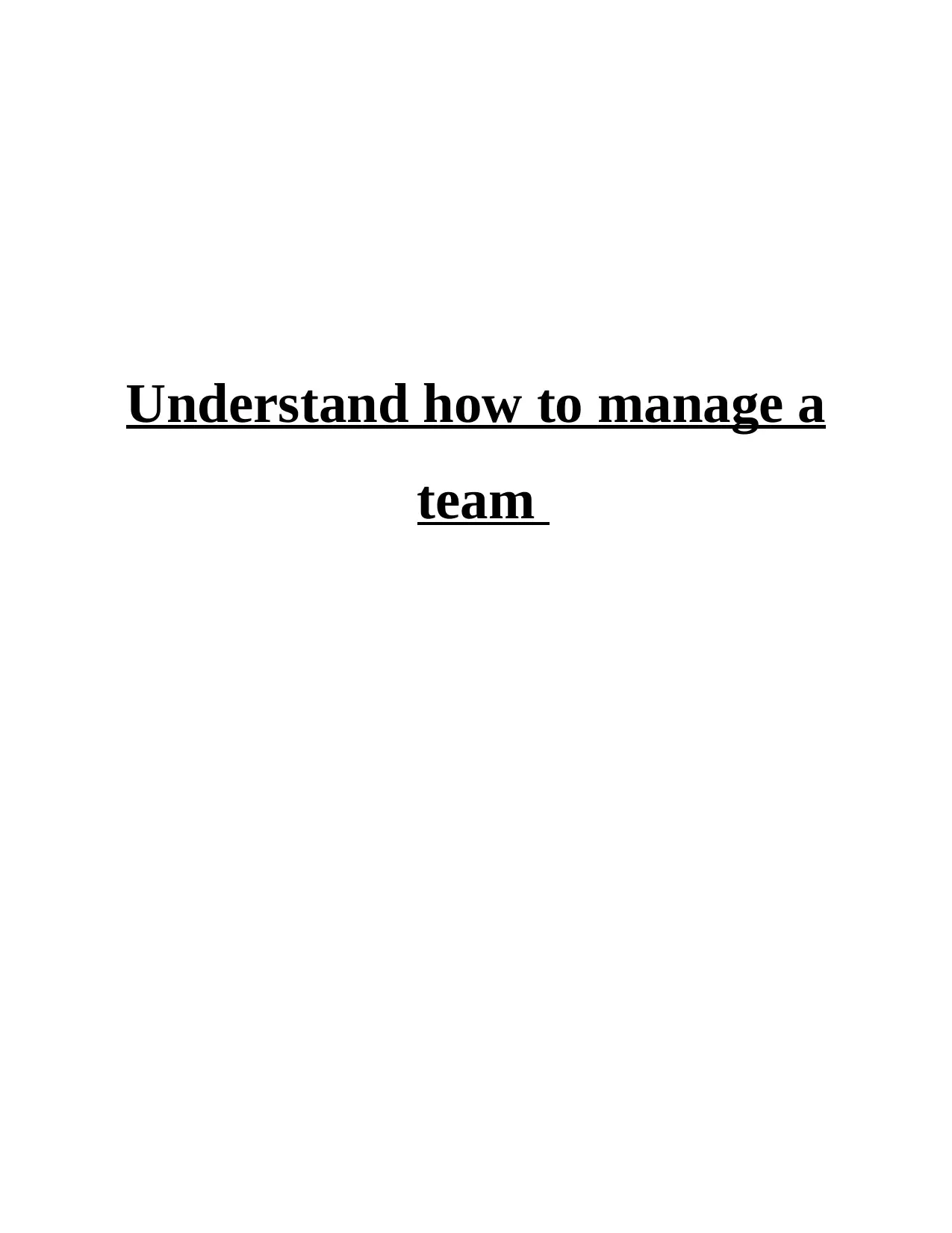
Understand how to manage a
team
team
Secure Best Marks with AI Grader
Need help grading? Try our AI Grader for instant feedback on your assignments.
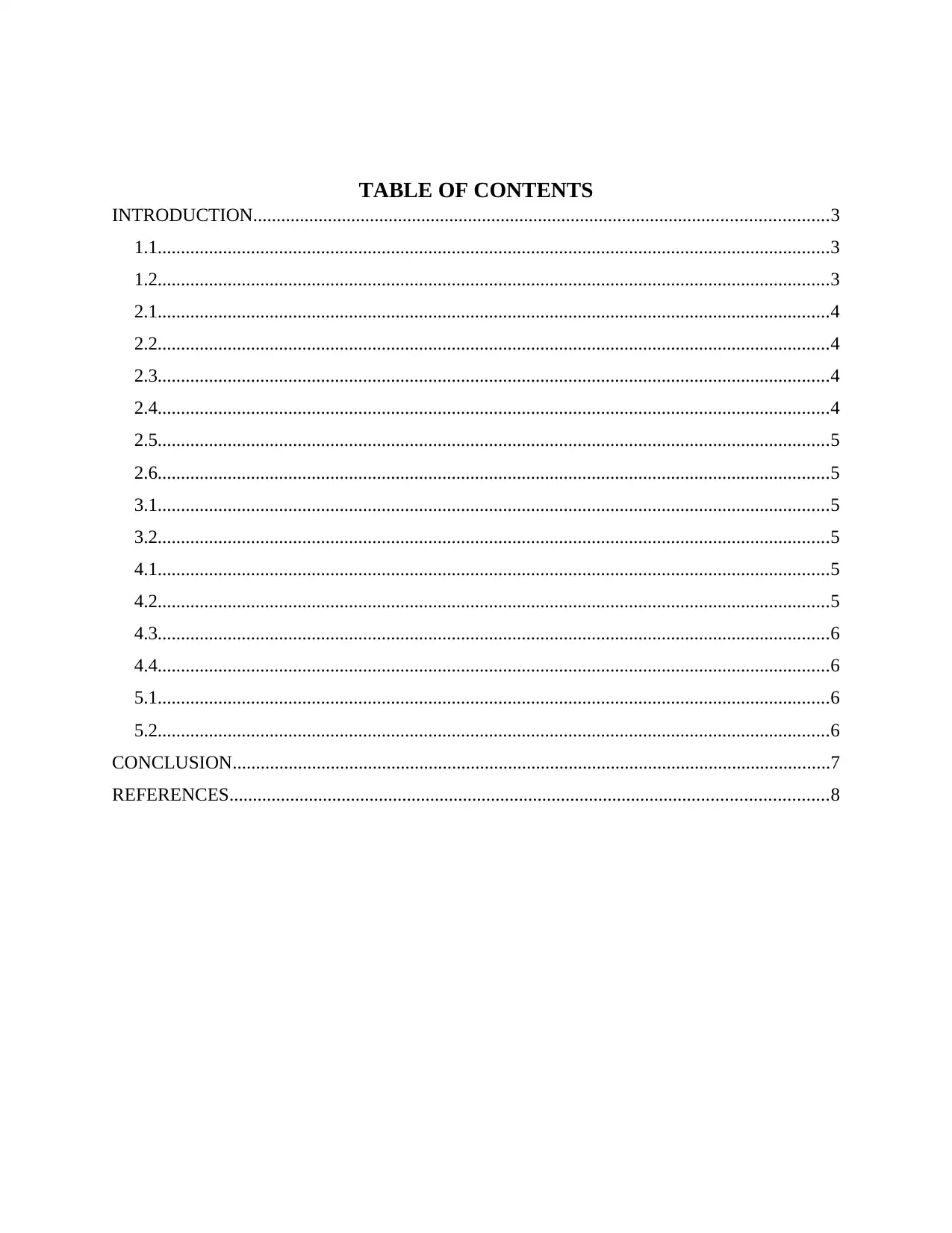
TABLE OF CONTENTS
INTRODUCTION...........................................................................................................................3
1.1................................................................................................................................................3
1.2................................................................................................................................................3
2.1................................................................................................................................................4
2.2................................................................................................................................................4
2.3................................................................................................................................................4
2.4................................................................................................................................................4
2.5................................................................................................................................................5
2.6................................................................................................................................................5
3.1................................................................................................................................................5
3.2................................................................................................................................................5
4.1................................................................................................................................................5
4.2................................................................................................................................................5
4.3................................................................................................................................................6
4.4................................................................................................................................................6
5.1................................................................................................................................................6
5.2................................................................................................................................................6
CONCLUSION................................................................................................................................7
REFERENCES................................................................................................................................8
INTRODUCTION...........................................................................................................................3
1.1................................................................................................................................................3
1.2................................................................................................................................................3
2.1................................................................................................................................................4
2.2................................................................................................................................................4
2.3................................................................................................................................................4
2.4................................................................................................................................................4
2.5................................................................................................................................................5
2.6................................................................................................................................................5
3.1................................................................................................................................................5
3.2................................................................................................................................................5
4.1................................................................................................................................................5
4.2................................................................................................................................................5
4.3................................................................................................................................................6
4.4................................................................................................................................................6
5.1................................................................................................................................................6
5.2................................................................................................................................................6
CONCLUSION................................................................................................................................7
REFERENCES................................................................................................................................8
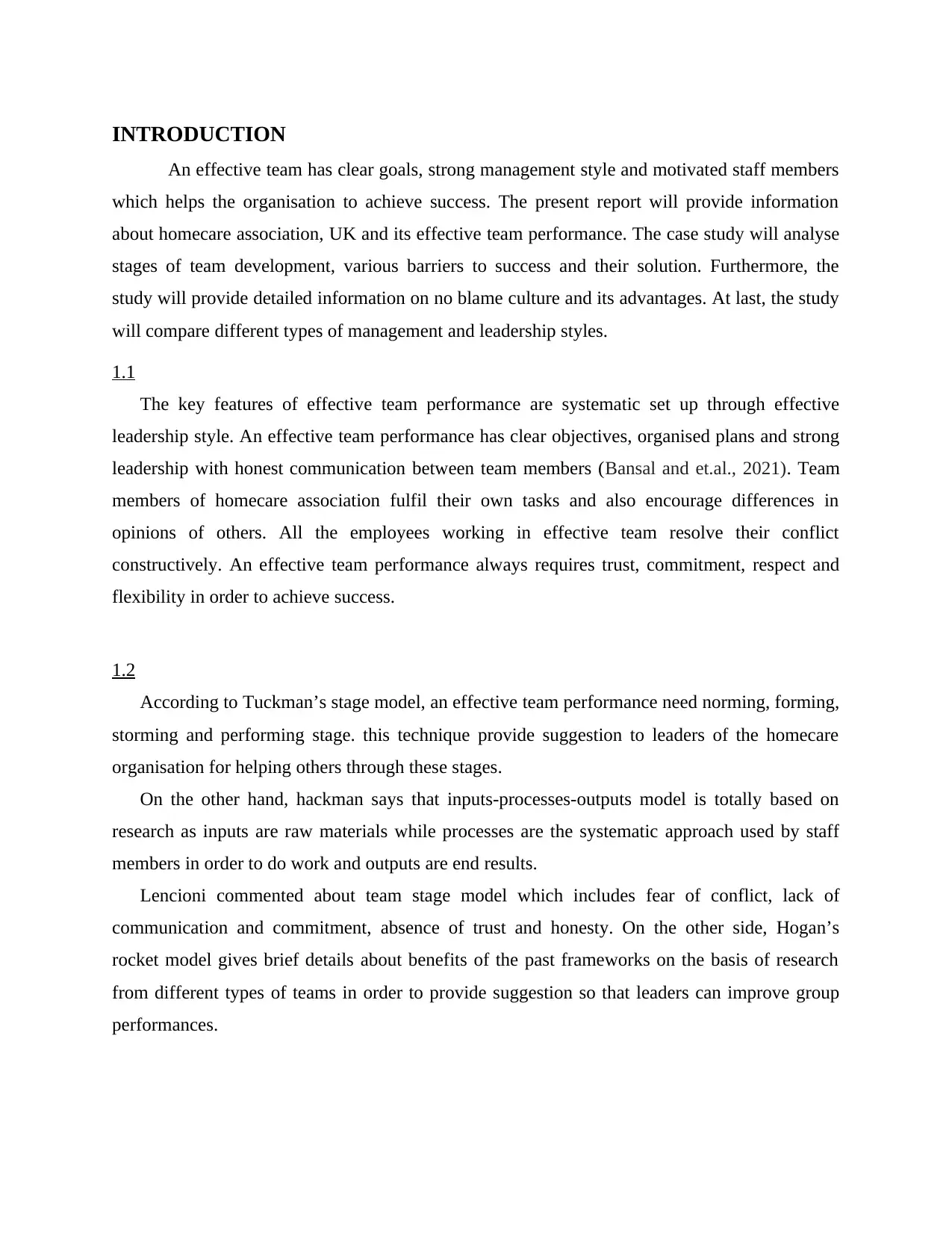
INTRODUCTION
An effective team has clear goals, strong management style and motivated staff members
which helps the organisation to achieve success. The present report will provide information
about homecare association, UK and its effective team performance. The case study will analyse
stages of team development, various barriers to success and their solution. Furthermore, the
study will provide detailed information on no blame culture and its advantages. At last, the study
will compare different types of management and leadership styles.
1.1
The key features of effective team performance are systematic set up through effective
leadership style. An effective team performance has clear objectives, organised plans and strong
leadership with honest communication between team members (Bansal and et.al., 2021). Team
members of homecare association fulfil their own tasks and also encourage differences in
opinions of others. All the employees working in effective team resolve their conflict
constructively. An effective team performance always requires trust, commitment, respect and
flexibility in order to achieve success.
1.2
According to Tuckman’s stage model, an effective team performance need norming, forming,
storming and performing stage. this technique provide suggestion to leaders of the homecare
organisation for helping others through these stages.
On the other hand, hackman says that inputs-processes-outputs model is totally based on
research as inputs are raw materials while processes are the systematic approach used by staff
members in order to do work and outputs are end results.
Lencioni commented about team stage model which includes fear of conflict, lack of
communication and commitment, absence of trust and honesty. On the other side, Hogan’s
rocket model gives brief details about benefits of the past frameworks on the basis of research
from different types of teams in order to provide suggestion so that leaders can improve group
performances.
An effective team has clear goals, strong management style and motivated staff members
which helps the organisation to achieve success. The present report will provide information
about homecare association, UK and its effective team performance. The case study will analyse
stages of team development, various barriers to success and their solution. Furthermore, the
study will provide detailed information on no blame culture and its advantages. At last, the study
will compare different types of management and leadership styles.
1.1
The key features of effective team performance are systematic set up through effective
leadership style. An effective team performance has clear objectives, organised plans and strong
leadership with honest communication between team members (Bansal and et.al., 2021). Team
members of homecare association fulfil their own tasks and also encourage differences in
opinions of others. All the employees working in effective team resolve their conflict
constructively. An effective team performance always requires trust, commitment, respect and
flexibility in order to achieve success.
1.2
According to Tuckman’s stage model, an effective team performance need norming, forming,
storming and performing stage. this technique provide suggestion to leaders of the homecare
organisation for helping others through these stages.
On the other hand, hackman says that inputs-processes-outputs model is totally based on
research as inputs are raw materials while processes are the systematic approach used by staff
members in order to do work and outputs are end results.
Lencioni commented about team stage model which includes fear of conflict, lack of
communication and commitment, absence of trust and honesty. On the other side, Hogan’s
rocket model gives brief details about benefits of the past frameworks on the basis of research
from different types of teams in order to provide suggestion so that leaders can improve group
performances.
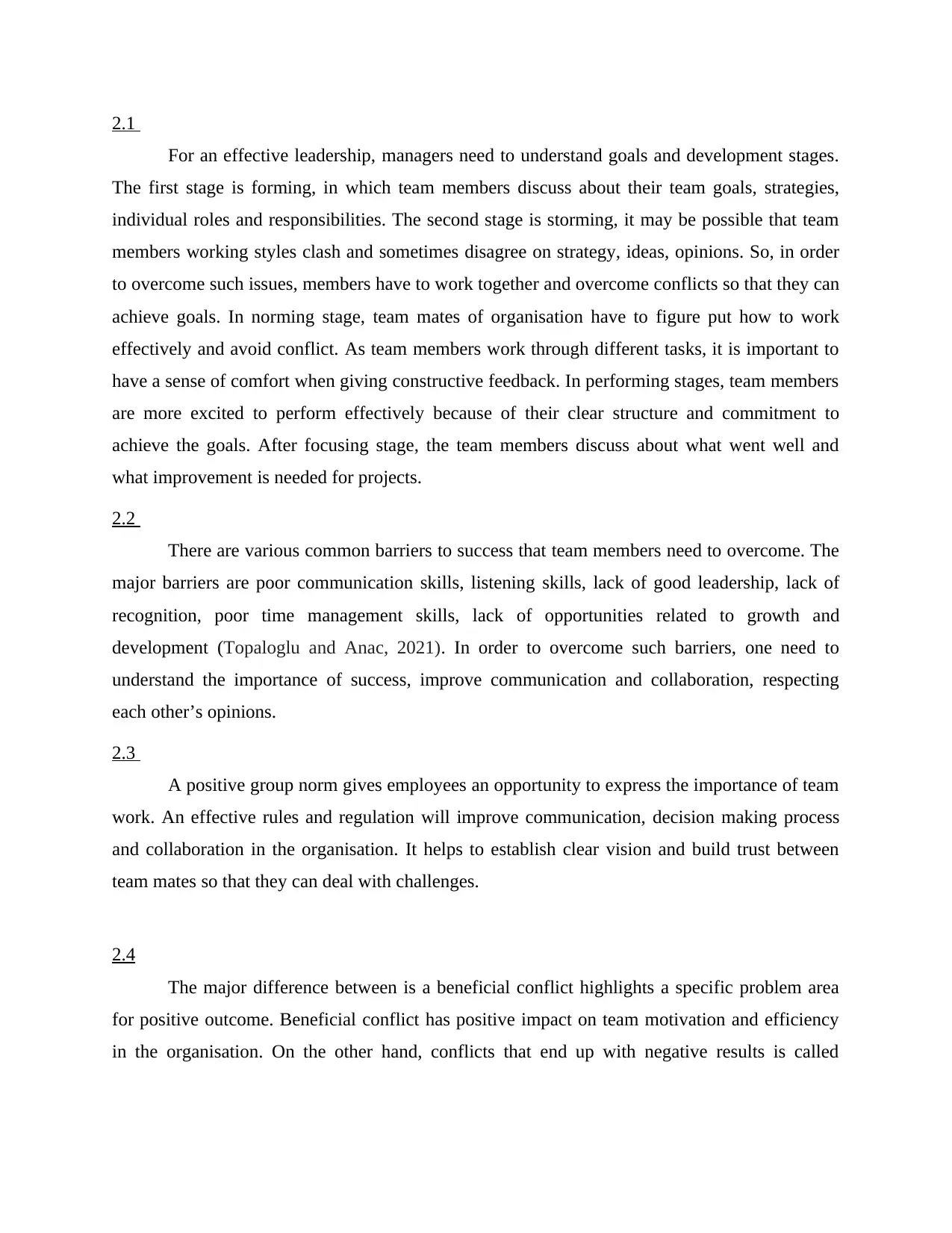
2.1
For an effective leadership, managers need to understand goals and development stages.
The first stage is forming, in which team members discuss about their team goals, strategies,
individual roles and responsibilities. The second stage is storming, it may be possible that team
members working styles clash and sometimes disagree on strategy, ideas, opinions. So, in order
to overcome such issues, members have to work together and overcome conflicts so that they can
achieve goals. In norming stage, team mates of organisation have to figure put how to work
effectively and avoid conflict. As team members work through different tasks, it is important to
have a sense of comfort when giving constructive feedback. In performing stages, team members
are more excited to perform effectively because of their clear structure and commitment to
achieve the goals. After focusing stage, the team members discuss about what went well and
what improvement is needed for projects.
2.2
There are various common barriers to success that team members need to overcome. The
major barriers are poor communication skills, listening skills, lack of good leadership, lack of
recognition, poor time management skills, lack of opportunities related to growth and
development (Topaloglu and Anac, 2021). In order to overcome such barriers, one need to
understand the importance of success, improve communication and collaboration, respecting
each other’s opinions.
2.3
A positive group norm gives employees an opportunity to express the importance of team
work. An effective rules and regulation will improve communication, decision making process
and collaboration in the organisation. It helps to establish clear vision and build trust between
team mates so that they can deal with challenges.
2.4
The major difference between is a beneficial conflict highlights a specific problem area
for positive outcome. Beneficial conflict has positive impact on team motivation and efficiency
in the organisation. On the other hand, conflicts that end up with negative results is called
For an effective leadership, managers need to understand goals and development stages.
The first stage is forming, in which team members discuss about their team goals, strategies,
individual roles and responsibilities. The second stage is storming, it may be possible that team
members working styles clash and sometimes disagree on strategy, ideas, opinions. So, in order
to overcome such issues, members have to work together and overcome conflicts so that they can
achieve goals. In norming stage, team mates of organisation have to figure put how to work
effectively and avoid conflict. As team members work through different tasks, it is important to
have a sense of comfort when giving constructive feedback. In performing stages, team members
are more excited to perform effectively because of their clear structure and commitment to
achieve the goals. After focusing stage, the team members discuss about what went well and
what improvement is needed for projects.
2.2
There are various common barriers to success that team members need to overcome. The
major barriers are poor communication skills, listening skills, lack of good leadership, lack of
recognition, poor time management skills, lack of opportunities related to growth and
development (Topaloglu and Anac, 2021). In order to overcome such barriers, one need to
understand the importance of success, improve communication and collaboration, respecting
each other’s opinions.
2.3
A positive group norm gives employees an opportunity to express the importance of team
work. An effective rules and regulation will improve communication, decision making process
and collaboration in the organisation. It helps to establish clear vision and build trust between
team mates so that they can deal with challenges.
2.4
The major difference between is a beneficial conflict highlights a specific problem area
for positive outcome. Beneficial conflict has positive impact on team motivation and efficiency
in the organisation. On the other hand, conflicts that end up with negative results is called
Secure Best Marks with AI Grader
Need help grading? Try our AI Grader for instant feedback on your assignments.
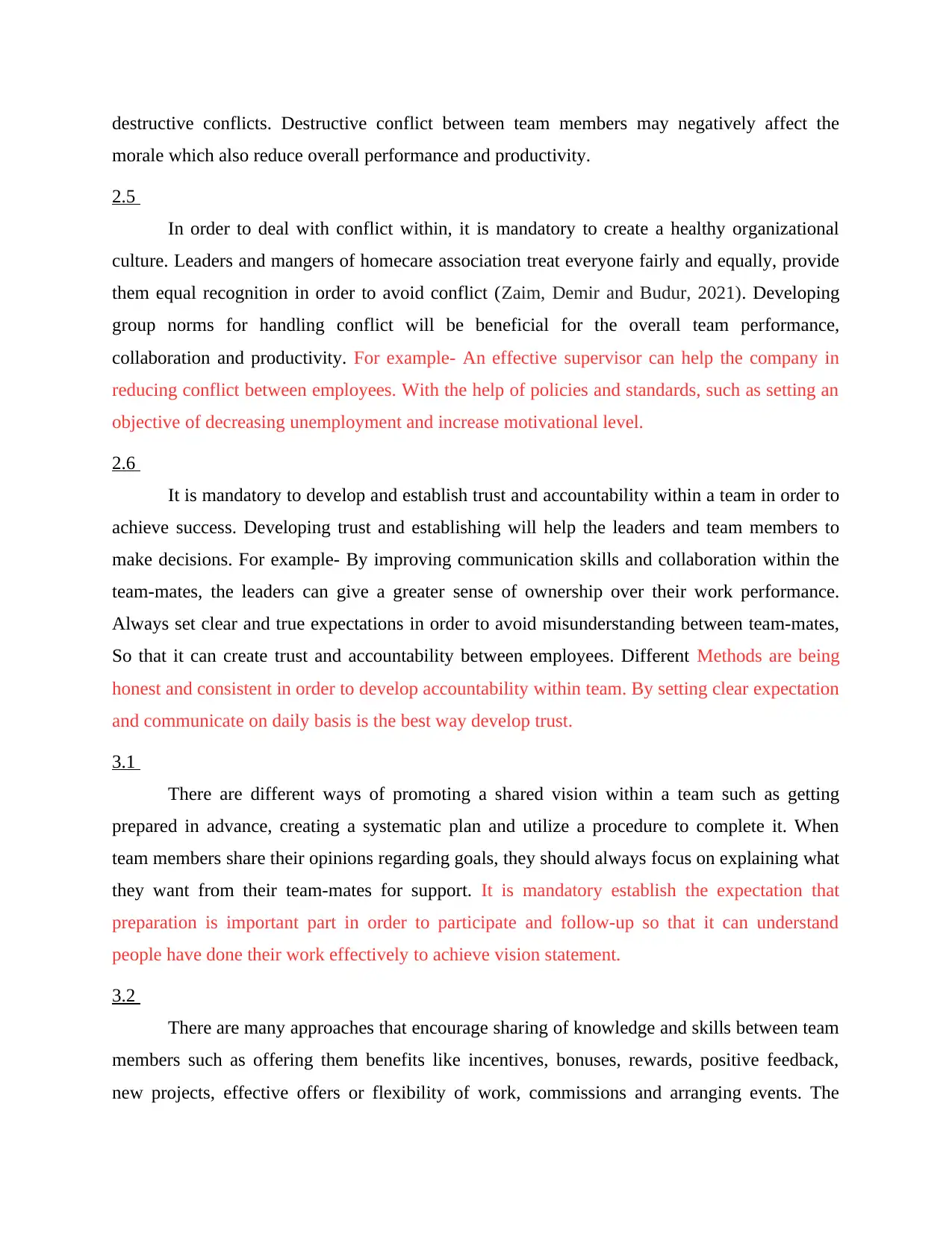
destructive conflicts. Destructive conflict between team members may negatively affect the
morale which also reduce overall performance and productivity.
2.5
In order to deal with conflict within, it is mandatory to create a healthy organizational
culture. Leaders and mangers of homecare association treat everyone fairly and equally, provide
them equal recognition in order to avoid conflict (Zaim, Demir and Budur, 2021). Developing
group norms for handling conflict will be beneficial for the overall team performance,
collaboration and productivity. For example- An effective supervisor can help the company in
reducing conflict between employees. With the help of policies and standards, such as setting an
objective of decreasing unemployment and increase motivational level.
2.6
It is mandatory to develop and establish trust and accountability within a team in order to
achieve success. Developing trust and establishing will help the leaders and team members to
make decisions. For example- By improving communication skills and collaboration within the
team-mates, the leaders can give a greater sense of ownership over their work performance.
Always set clear and true expectations in order to avoid misunderstanding between team-mates,
So that it can create trust and accountability between employees. Different Methods are being
honest and consistent in order to develop accountability within team. By setting clear expectation
and communicate on daily basis is the best way develop trust.
3.1
There are different ways of promoting a shared vision within a team such as getting
prepared in advance, creating a systematic plan and utilize a procedure to complete it. When
team members share their opinions regarding goals, they should always focus on explaining what
they want from their team-mates for support. It is mandatory establish the expectation that
preparation is important part in order to participate and follow-up so that it can understand
people have done their work effectively to achieve vision statement.
3.2
There are many approaches that encourage sharing of knowledge and skills between team
members such as offering them benefits like incentives, bonuses, rewards, positive feedback,
new projects, effective offers or flexibility of work, commissions and arranging events. The
morale which also reduce overall performance and productivity.
2.5
In order to deal with conflict within, it is mandatory to create a healthy organizational
culture. Leaders and mangers of homecare association treat everyone fairly and equally, provide
them equal recognition in order to avoid conflict (Zaim, Demir and Budur, 2021). Developing
group norms for handling conflict will be beneficial for the overall team performance,
collaboration and productivity. For example- An effective supervisor can help the company in
reducing conflict between employees. With the help of policies and standards, such as setting an
objective of decreasing unemployment and increase motivational level.
2.6
It is mandatory to develop and establish trust and accountability within a team in order to
achieve success. Developing trust and establishing will help the leaders and team members to
make decisions. For example- By improving communication skills and collaboration within the
team-mates, the leaders can give a greater sense of ownership over their work performance.
Always set clear and true expectations in order to avoid misunderstanding between team-mates,
So that it can create trust and accountability between employees. Different Methods are being
honest and consistent in order to develop accountability within team. By setting clear expectation
and communicate on daily basis is the best way develop trust.
3.1
There are different ways of promoting a shared vision within a team such as getting
prepared in advance, creating a systematic plan and utilize a procedure to complete it. When
team members share their opinions regarding goals, they should always focus on explaining what
they want from their team-mates for support. It is mandatory establish the expectation that
preparation is important part in order to participate and follow-up so that it can understand
people have done their work effectively to achieve vision statement.
3.2
There are many approaches that encourage sharing of knowledge and skills between team
members such as offering them benefits like incentives, bonuses, rewards, positive feedback,
new projects, effective offers or flexibility of work, commissions and arranging events. The
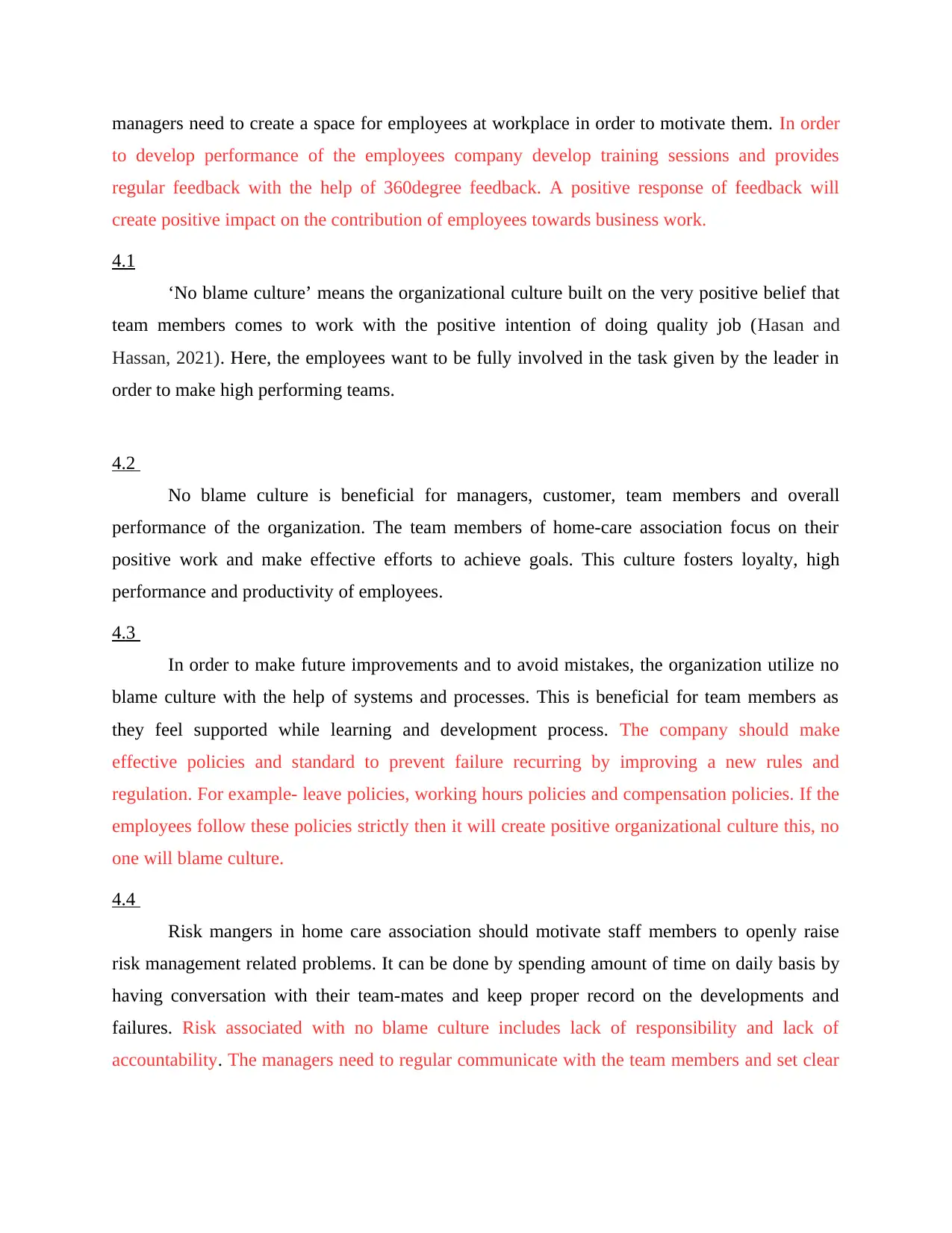
managers need to create a space for employees at workplace in order to motivate them. In order
to develop performance of the employees company develop training sessions and provides
regular feedback with the help of 360degree feedback. A positive response of feedback will
create positive impact on the contribution of employees towards business work.
4.1
‘No blame culture’ means the organizational culture built on the very positive belief that
team members comes to work with the positive intention of doing quality job (Hasan and
Hassan, 2021). Here, the employees want to be fully involved in the task given by the leader in
order to make high performing teams.
4.2
No blame culture is beneficial for managers, customer, team members and overall
performance of the organization. The team members of home-care association focus on their
positive work and make effective efforts to achieve goals. This culture fosters loyalty, high
performance and productivity of employees.
4.3
In order to make future improvements and to avoid mistakes, the organization utilize no
blame culture with the help of systems and processes. This is beneficial for team members as
they feel supported while learning and development process. The company should make
effective policies and standard to prevent failure recurring by improving a new rules and
regulation. For example- leave policies, working hours policies and compensation policies. If the
employees follow these policies strictly then it will create positive organizational culture this, no
one will blame culture.
4.4
Risk mangers in home care association should motivate staff members to openly raise
risk management related problems. It can be done by spending amount of time on daily basis by
having conversation with their team-mates and keep proper record on the developments and
failures. Risk associated with no blame culture includes lack of responsibility and lack of
accountability. The managers need to regular communicate with the team members and set clear
to develop performance of the employees company develop training sessions and provides
regular feedback with the help of 360degree feedback. A positive response of feedback will
create positive impact on the contribution of employees towards business work.
4.1
‘No blame culture’ means the organizational culture built on the very positive belief that
team members comes to work with the positive intention of doing quality job (Hasan and
Hassan, 2021). Here, the employees want to be fully involved in the task given by the leader in
order to make high performing teams.
4.2
No blame culture is beneficial for managers, customer, team members and overall
performance of the organization. The team members of home-care association focus on their
positive work and make effective efforts to achieve goals. This culture fosters loyalty, high
performance and productivity of employees.
4.3
In order to make future improvements and to avoid mistakes, the organization utilize no
blame culture with the help of systems and processes. This is beneficial for team members as
they feel supported while learning and development process. The company should make
effective policies and standard to prevent failure recurring by improving a new rules and
regulation. For example- leave policies, working hours policies and compensation policies. If the
employees follow these policies strictly then it will create positive organizational culture this, no
one will blame culture.
4.4
Risk mangers in home care association should motivate staff members to openly raise
risk management related problems. It can be done by spending amount of time on daily basis by
having conversation with their team-mates and keep proper record on the developments and
failures. Risk associated with no blame culture includes lack of responsibility and lack of
accountability. The managers need to regular communicate with the team members and set clear
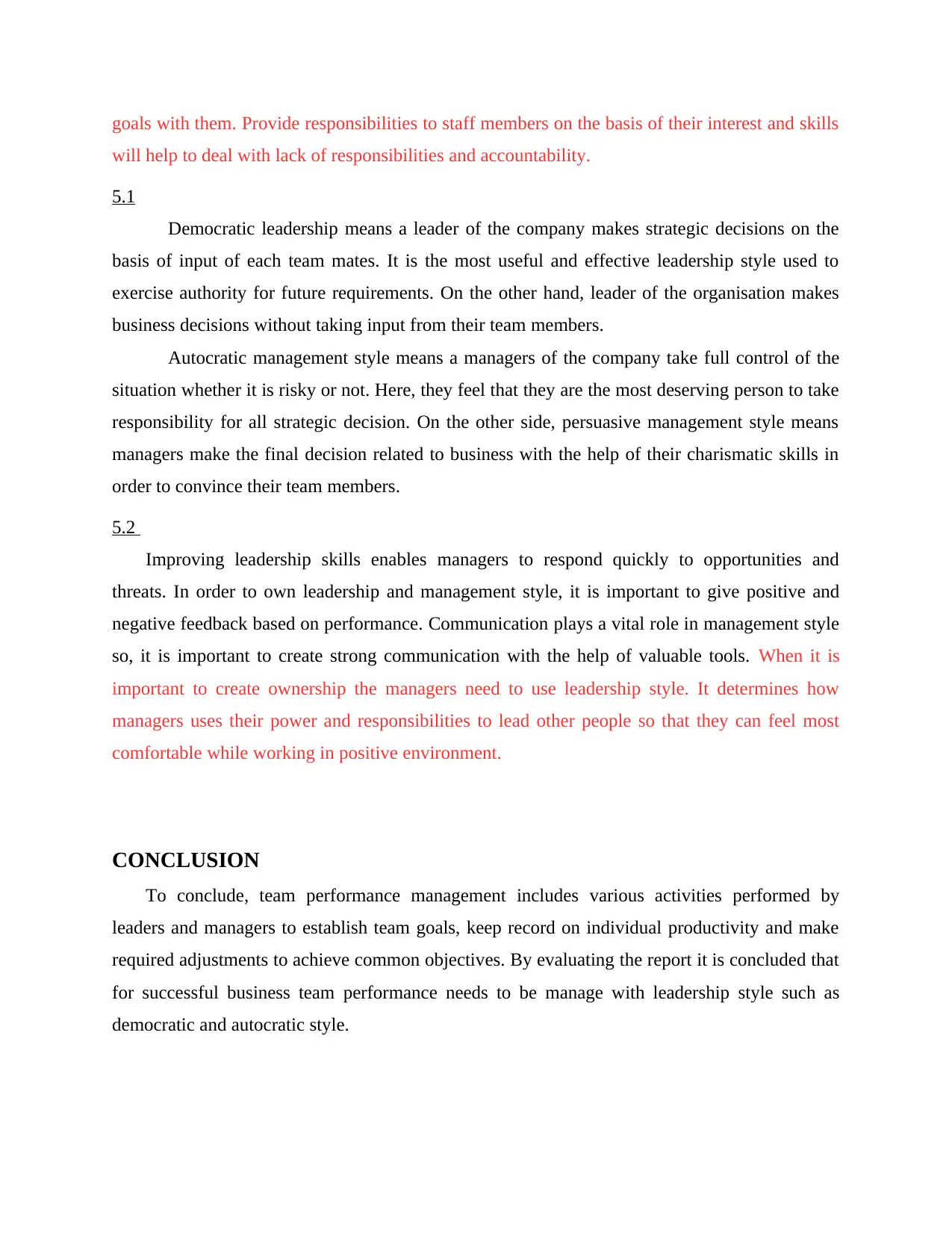
goals with them. Provide responsibilities to staff members on the basis of their interest and skills
will help to deal with lack of responsibilities and accountability.
5.1
Democratic leadership means a leader of the company makes strategic decisions on the
basis of input of each team mates. It is the most useful and effective leadership style used to
exercise authority for future requirements. On the other hand, leader of the organisation makes
business decisions without taking input from their team members.
Autocratic management style means a managers of the company take full control of the
situation whether it is risky or not. Here, they feel that they are the most deserving person to take
responsibility for all strategic decision. On the other side, persuasive management style means
managers make the final decision related to business with the help of their charismatic skills in
order to convince their team members.
5.2
Improving leadership skills enables managers to respond quickly to opportunities and
threats. In order to own leadership and management style, it is important to give positive and
negative feedback based on performance. Communication plays a vital role in management style
so, it is important to create strong communication with the help of valuable tools. When it is
important to create ownership the managers need to use leadership style. It determines how
managers uses their power and responsibilities to lead other people so that they can feel most
comfortable while working in positive environment.
CONCLUSION
To conclude, team performance management includes various activities performed by
leaders and managers to establish team goals, keep record on individual productivity and make
required adjustments to achieve common objectives. By evaluating the report it is concluded that
for successful business team performance needs to be manage with leadership style such as
democratic and autocratic style.
will help to deal with lack of responsibilities and accountability.
5.1
Democratic leadership means a leader of the company makes strategic decisions on the
basis of input of each team mates. It is the most useful and effective leadership style used to
exercise authority for future requirements. On the other hand, leader of the organisation makes
business decisions without taking input from their team members.
Autocratic management style means a managers of the company take full control of the
situation whether it is risky or not. Here, they feel that they are the most deserving person to take
responsibility for all strategic decision. On the other side, persuasive management style means
managers make the final decision related to business with the help of their charismatic skills in
order to convince their team members.
5.2
Improving leadership skills enables managers to respond quickly to opportunities and
threats. In order to own leadership and management style, it is important to give positive and
negative feedback based on performance. Communication plays a vital role in management style
so, it is important to create strong communication with the help of valuable tools. When it is
important to create ownership the managers need to use leadership style. It determines how
managers uses their power and responsibilities to lead other people so that they can feel most
comfortable while working in positive environment.
CONCLUSION
To conclude, team performance management includes various activities performed by
leaders and managers to establish team goals, keep record on individual productivity and make
required adjustments to achieve common objectives. By evaluating the report it is concluded that
for successful business team performance needs to be manage with leadership style such as
democratic and autocratic style.
Paraphrase This Document
Need a fresh take? Get an instant paraphrase of this document with our AI Paraphraser

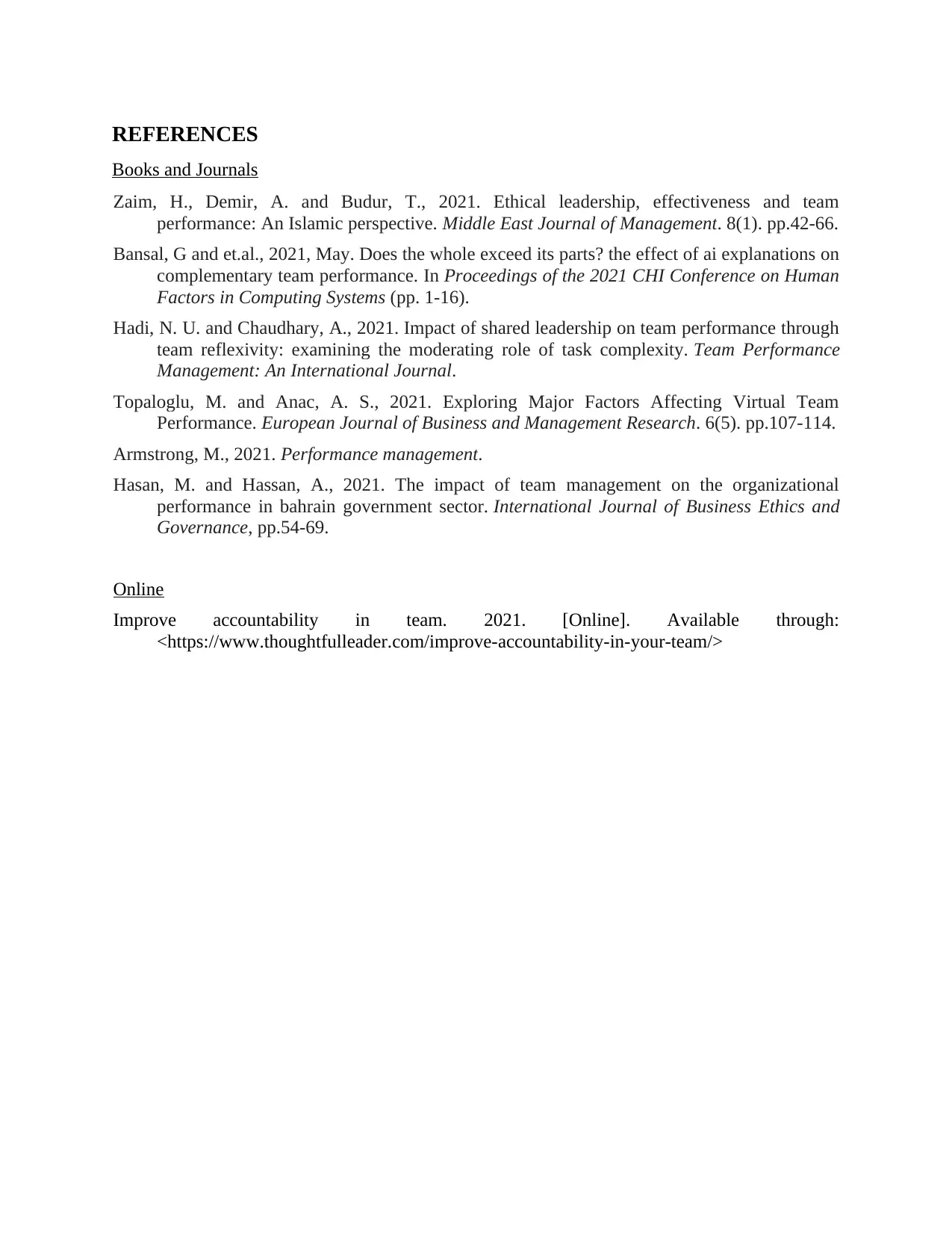
REFERENCES
Books and Journals
Zaim, H., Demir, A. and Budur, T., 2021. Ethical leadership, effectiveness and team
performance: An Islamic perspective. Middle East Journal of Management. 8(1). pp.42-66.
Bansal, G and et.al., 2021, May. Does the whole exceed its parts? the effect of ai explanations on
complementary team performance. In Proceedings of the 2021 CHI Conference on Human
Factors in Computing Systems (pp. 1-16).
Hadi, N. U. and Chaudhary, A., 2021. Impact of shared leadership on team performance through
team reflexivity: examining the moderating role of task complexity. Team Performance
Management: An International Journal.
Topaloglu, M. and Anac, A. S., 2021. Exploring Major Factors Affecting Virtual Team
Performance. European Journal of Business and Management Research. 6(5). pp.107-114.
Armstrong, M., 2021. Performance management.
Hasan, M. and Hassan, A., 2021. The impact of team management on the organizational
performance in bahrain government sector. International Journal of Business Ethics and
Governance, pp.54-69.
Online
Improve accountability in team. 2021. [Online]. Available through:
<https://www.thoughtfulleader.com/improve-accountability-in-your-team/>
Books and Journals
Zaim, H., Demir, A. and Budur, T., 2021. Ethical leadership, effectiveness and team
performance: An Islamic perspective. Middle East Journal of Management. 8(1). pp.42-66.
Bansal, G and et.al., 2021, May. Does the whole exceed its parts? the effect of ai explanations on
complementary team performance. In Proceedings of the 2021 CHI Conference on Human
Factors in Computing Systems (pp. 1-16).
Hadi, N. U. and Chaudhary, A., 2021. Impact of shared leadership on team performance through
team reflexivity: examining the moderating role of task complexity. Team Performance
Management: An International Journal.
Topaloglu, M. and Anac, A. S., 2021. Exploring Major Factors Affecting Virtual Team
Performance. European Journal of Business and Management Research. 6(5). pp.107-114.
Armstrong, M., 2021. Performance management.
Hasan, M. and Hassan, A., 2021. The impact of team management on the organizational
performance in bahrain government sector. International Journal of Business Ethics and
Governance, pp.54-69.
Online
Improve accountability in team. 2021. [Online]. Available through:
<https://www.thoughtfulleader.com/improve-accountability-in-your-team/>
1 out of 9
Related Documents
Your All-in-One AI-Powered Toolkit for Academic Success.
+13062052269
info@desklib.com
Available 24*7 on WhatsApp / Email
![[object Object]](/_next/static/media/star-bottom.7253800d.svg)
Unlock your academic potential
© 2024 | Zucol Services PVT LTD | All rights reserved.





